|
How Old is That Thar Jar?
By Peter Wingard
|
 |
One aspect of evaluating pottery, in my case Southern pottery, is determining
its relative age. Most collectors know this by experience. But I get questions
from new collectors often that basically ask, how do I know if a particular
piece of pottery I have is old? My answer is a question in return. When you walk
in the woods, how can you tell a pine tree from an oak? My point is that to
identify pine trees from oaks, you could first learn that pine trees are green
year round. Then you build on your knowledge from there.
What follows is a
couple of good first steps to help identify the age of Southern pottery.
FORM. Early on, Southern pottery was ovoid. Within a few short years it
became more bulbous.
The first potters were English trained. These potters
followed the English tradition of ovoid-shaped pottery. Later, as others became
involved in turning pottery in Edgefield, notably Germans and African slaves,
the shape became more bulbous. Bulbous is rounder in the middle as opposed to
ovoid, which is more rounded toward the shoulders. Bulbous pottery soon replaced
ovoid pottery after a short period. Then, over time, the sides began to flatten
out from bulbous to rounded and then straight sided to finally tooled shoulder
or stacker jugs.
Why did these changes in form occur? There are a number of
reasons. Before the Civil War, the plantation economy required large storage
vessels, 10, 20, even 40 gallons in size. Bulbous pottery could hold more than
ovoid, therefore, bulbous pottery became the norm. After the Civil War, these
large storage vessels were no longer needed with the demise of the plantations.
Potters produced smaller containers like churns and canning jars for the local
farmers and merchants. These forms tended to be less bulbous, but still had
somewhat rounded sides.
Technology and transportation also improved towards
the turn of the century. You could ship more jugs in a box if the sides of the
jugs were straight. Large-scale potteries out West and up North were producing
straight-sided jugs and jars and shipping them all over the country. These
industrial-scaled potteries employed machinery. The machines could easily
produce straight-sided jugs with unskilled labor.
With a flood of pottery
from outside the South, the cost of pottery in the marketplace fell. The local
potters had to cut costs or go out of business. This generally happened earlier
in the urban potteries around cities like Atlanta where competitive goods could
be easily shipped in from many miles away. In relatively more remote areas, the
competition from the outside came much later so the styles did not change until
later, if at all.
Another factor was the way potteries were run. After the
plantation potteries ceased to exist, many of the potters began to migrate,
finding work in whatever shop would hire them. These itinerant potters were paid
by the piece or gallon. Because of this, they turned out pieces quicker and with
less care. The straight-sided jug or jar was easier and quicker to make.
Quantity became more important than quality.
Technology also brought cheaper
or better alternatives to traditional stoneware. This included mason jars and
refrigeration. This also decreased the demand for local stoneware, which
increased pressure to lower costs.
DETAIL. The better the apparent
workmanship in the stoneware, the earlier the piece. As stated above, because of
competition and technology, local potters had to make their ware faster and
cheaper. Frills such as decorating the pottery became less common. Add to this
the compounding factor that the Southern economy was ruined after the Civil War.
The locals could not afford extravagance. This is not only evident in lack of
decoration, but can also be seen in the reduction of the general quality of the
workmanship as well. How much care was put into making and attaching the handle?
How graceful is the shape? How delicate was the workmanship in the shoulder,
collar or rim? Pay attention to the fine details or lack thereof. The earlier
pieces tend to have better workmanship.
A Fancy Handle on a North Carolina
Jar and a Catawba Valley large two-handled jug with extraordinary
workmanship.
GLAZE. Alkaline glaze is the defining characteristic of Southern
pottery. It is what makes it distinctive from other pottery and very
collectable. But there are other glazes on Southern pottery, most notably salt
glaze and slip glaze. There are regions in the South where pottery has a long
tradition of salt glazing. This is true in the Piedmont area of North
Carolina.
What began as an experiment quickly became a unique Southern
tradition in stoneware manufacture. Using alkaline glaze on Southern stoneware
is first attributed to Abner Landrum who borrowed the idea from the ancient
Chinese. The alkaline glazing is believed to have first begun at the
Pottersville pottery site in Edgefield South Carolina in the early 1800s.
Alkaline glazing of stoneware spread to other potteries in Edgefield and other
locations of South Carolina, North Carolina, Georgia, Alabama and even as far
west as Texas in a very few short years.
Why did alkaline glazes come about?
Alkaline glazing avoided the dependence on expensive, hard-to-get salt and could
be made out of materials found locally in abundance. Salt glazing remained
predominant up north. Alkaline glaze posed no health hazard, as did the
lead-based glazes. There was a dawning awareness at that time that lead glazes,
very popular up till then, were actually dangerous. Stoneware was primarily used
to store food. The acids naturally occurring in some foods would dissolve the
lead from lead-based glaze, allowing it to be absorbed into the food. When
consumed over a long period of time, this tainted food could cause lead
poisoning.
What does glaze have to do with age? Again, as a generalization,
alkaline glaze was used extensively in many Southern potteries from the early
1800s until the end of the century. Although it could be made out of readily
available materials, it was a time-consuming process. When competition
increased, the local potters began to look for alternative methods that were
less time consuming. In some cases, they switched to salt glazing, which had
become somewhat more affordable as the country's transportation system grew more
dependable.
But many potteries switched to slip glazes. Slip glazes were not
as attractive or as durable as alkaline glazes, but they could be bought by the
bagful or could be easily mixed using local clays. By the turn of the century,
most potteries were using slip glaze, especially in the more urban areas.
Remember, this is a generalization. Some areas in the South never used alkaline
glaze while other areas rarely used slip or salt glazing, even after
1900.
MARKS. If a piece of pottery is marked and you know whose mark it is,
you can attribute the age of the pot to sometime during that potter's (or
pottery's) active period. The marks may clearly be a potter's name and even
location, or the marks may be more cryptic, like slashes at the top or bottom.
It could be initials or small symbols like horseshoe-shaped marks, circles,
crosses, etc . Some people collect nothing but signed or marked pottery, in part
because it reassures them that what they are collecting is in fact old. Marked
pottery also helps in dating similar, unmarked wares.
IMPERFECTIONS and
VARIATIONS. Older pottery has more imperfections and variations. Not really
flaws, but subtle differences in the finished product. In older pottery, the
clay would always be hand dug. The glazes would always be homemade. That means
that the clay would have all manner of things mixed into it. Even though the
potter would process the clay (some more than others), it would still have bits
of rock or flecks of minerals or even organic substances in it, causing color
and texture variations in the glaze or on the surface. The finished product, the
unique combination of clay, glaze, and firing, could vary dramatically from
piece to piece and firing to firing.
Over the course of the 20th century,
commercial clays and glazes became readily available. Large wood-fired kilns
were replaced with smaller, more dependable, temperature-controlled gas or even
electric kilns. The overall effect of this technological shift is a reduction in
the variety and amount of imperfections and variations that can be seen in the
pottery. These variations not only help in judging the age of pottery, but
sometimes they give added interest as well.
There are potters who make
pottery the old way, even today. Digging their own clay, mixing their own recipe
glazes, and firing the wares in the old wood-fired kilns.
WEAR. Finally, I
will mention wear. If it is old, it should have some wear. Keep in mind that
alkaline glazes are very tough and can, even after 150 years, look like the day
they were made. Even so, you should still be able to detect some wear. There
should be some wear around the base edge. You should feel no or few sharp points
running your hand over the surface of the piece.
There are plenty of
exceptions to the above generalizations. The two handled jug cited above as an
example of exceptional workmanship was from the shop of Samuel Propst. He made
pottery up through the first quarter of the 20th century in Catawba Valley North
Carolina. So this is not a particularly early piece as the quality might
suggest. Why?
Samuel Propst ran his own shop and made all his own ware. He
obviously took particular pride in his work. It also helped that he was in an
area that rewarded his workmanship by paying a little extra to buy his pottery
when cheaper alternatives existed.
Form, detail, glaze, marks, imperfections
or variations, and wear are some keys to look for when estimating the age of
Southern pottery. Becoming more familiar with these concepts should help the
novice collector.
Each area has its own distinct past that often will defy
simple generalizations. The South has a wide and diverse area of pottery to
collect from. With a 200-year history covering multiple states, there is plenty
to explore and learn while collecting pottery. Good
hunting!
Pete Wingard is the owner of Mud, Sweat and Tears
Southern Antique Stoneware at 216 Heatherdown Rd., Decatur, Ga. He is available
by appointment at 404-378-9471 or netlatch@hotmail.com. Visit his website at
www.mudsweatandtears.com
.
|
All photos courtesy,
Pete Wingard.
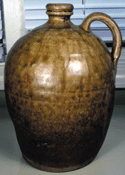
Bulbous jars held more, but weren't efficient for
transporting. They pre-date
rounded and stacker jugs.

Early decorated Edgefield,
S.C., jar.
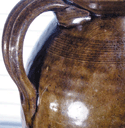
Detail,
decoration or a fancy
handle point to an earlier jar.
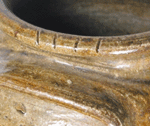
These slashes help date this jar to pre-Civil War.

E.L. Stork, Orange, Ga., jar, ca. 1910.
Marks make dating easier.

B.S. Salter mark,
ca. 1900.
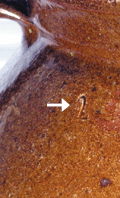
"L" mark from unknown potter in Crawford or Washington Co.,
Ga.
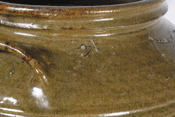
Horseshoe with slash.
Slaves often marked their work
with
symbols.
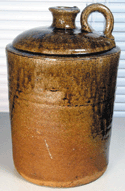
(left) Tooled shoulder or stacker jugs were created for shipping.
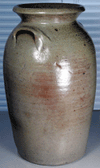
Ca. 1860 salt-glazed
North Carolina jar.
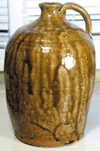
Rounded jar shapes followed bulbous jars.
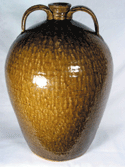
Generally, the better the
workmanship, the earlier the jar, such as this
exquisite two-
handled Catawba Valley jug.
|